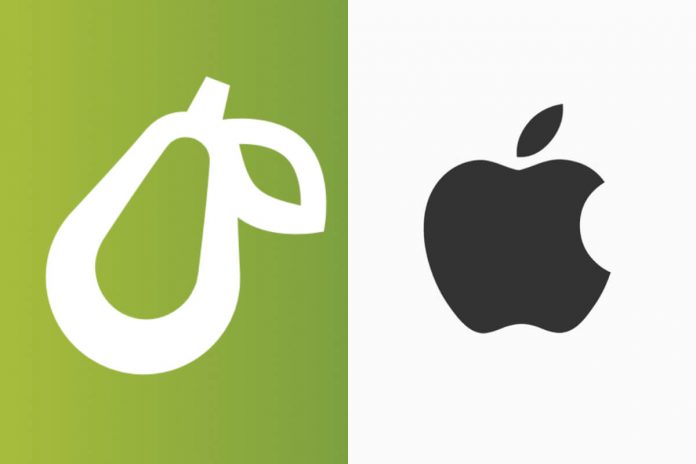This article is written by Anshal Dhiman, pursuing BA.LLB (Hons.). The article talks about the recent trademark war between Apple and Prepear.
Table of Contents
Introduction
Trademarks are an important part of modern day businesses. They represent the business to the world. A good trademark can be very helpful to a business to gain monetary profits and become popular. Trademarks have become a very important part of Intellectual Property Rights, and have a great effect in helping to distinguish one business from another. In the modern world, with increasing startups and growing businesses, there are always going to be issues relating to Intellectual Property Rights. In the millions of trademarks that are filed everyday and are being used by the businesses, be it new or old. This must make people think why there are no clashes amongst different trademarks since some of them might be similar to each other, because of the number of trademarks that are present in the world. Regardless, when there exists a condition of unapproved use of a selected brand name or when a substance accepts a misleadingly relative or unclear engraving, such an action would put a case for infringement of the enrolled brand name. Associations, as needs are, look to viably shield their selected image names from infringement by others. This article will talk about one such case where a big company has tried to cross some limits in order to protect their trademark, the case of Apple and Prepear, which was settled recently in February 2021.
What is known as trademark bullying?
Trademark bullying or trademark troll is a term that has been used and the practice of it has been witnessed quite a few times these days (Momentum Luggage & Leisure Bags v Jansport, Inc.) Basically, trademark bullying means the use of excessively aggressive techniques to protect one’s trademark, even if it crosses the scope of trademark, and in the end, depends upon how strong the troll is and how much control it has over the market and the regulators. In a typical trademark bullying scenario, there would be a big company that has access to a large number of sources, economic and otherwise, and there would be a target, mostly small startups and businesses that may not have the legal and economic resources to fight the big businesses, and hence, can be harassed by the big companies for their trademark rights, which eventually leads them to be bullied and giving up their rights to a certain trademark.
When does trademark bullying start?
Though most people believe that a case of trademark bullying may start when a lawsuit is filed by a big company against a small startup, the actual starts way before an actual lawsuit is filed, and as the reader can imagine the mental problems a small business may suffer when they are forced into changing their trademark. Another problem with the concept of trademark bullying is that most big companies do not intend to use the trademark of the small startup anyways. The company doesn’t really utilize or plan to utilize the brand name, yet shrewdly petitions for a brand name (notable or not) that has been enlisted by another organization in different nations or in different classes. Thus, the savage holds the brand name for recovery, requesting a permit or buy charge when the authentic proprietor chooses to broaden its brand name insurance. A company with a grounded reputation in at any rate one country partakes in intense prerequisite of its brands past its certified local lines and furthermore business scope, bringing exercises against various associations that use the same or relative engravings in various countries or in arbitrary domains.
The emphasis on tormenting in brand name cases may neglect the more extensive issue of injurious prosecution in different zones of law. A few organizations believe patent savages to be the scourge of patent law. Specialists see individual injury legal counselors as victimizers of the general set of laws, who look to blackmail monetary repayment from litigants instead of gaining proficiency with reality. Since most state bar lawful moral rules expect lawyers to address their customers “enthusiastically”, it is maybe obvious that a few lawyers may cross the foggy line and take part in harsh case strategies. To the extent brand name matters go, exuberant portrayal may stem to a limited extent from case law expressing that rights holders have an obligation to be careful about securing their imprints
How do the big companies exert pressure on smaller brands?
A brand name hazard uses threats of argument against another association that is obviously and past any reasonable vulnerability working inside the constraints of brand name law. Brand name threats use brand name law as a mask; they will likely drive competitors or those they comprehend as competitors, bankrupt. They generally accomplish this by finding a way to sue, being a lot mindful of the way that various little competitors can’t deal with the expense of the costs related to long arraignment. American companies like Monster and McDonalds have been known to be trademark bullies of the region as they have in many instances tried to stop small startups from using names related to their or trademarks that might be related to them even though a minor detail, even if those startups do not lie in their fields and may not have any effect on them whatsoever. The weight of verification, which lies on the applicant, is very high; it is consistently hard to give clear and unquestionable proof of malignant aim. Luckily, the fake expectation is typically controlled by French courts dependent on the assortment of proof, emerging from such factors as notoriety of the prior imprint abroad and in France; a closeness between the imprints and products and ventures; nonattendance of utilization; the candidate going to similar shows or occasions as the real brand proprietor; the candidate being a previous worker, wholesaler or project worker; and verifications of customary travel in the nation of the real proprietor.
The case of Apple and Prepear
Apple’s objections to Prepear’s logo
Prepear is a cooking application, available on both Android and macOS. We don’t need any introduction to Apple Inc. It is one of the biggest tech giants in the world. It is a funny question how a trademark battle between these two entities could arise because they are very much not related to each other. In 2017, Super Healthy Kids, the parent association of Prepear, registered a brand name application for their moderate logo of a pear. In 2019, the US Patent and Brand name Office (USPTO) communicated the engraving without any fights. On the latest day of recording objections with the USPTO, nevertheless, Apple objected against Prepear’s logo, referring to a sensible confusion might arise between the logos of the two associations due to a clouding between the two. Tech goliath Apple is restricting the exchange mark enrollment of food prep application Prepear’s logo, as they contend that their green pear logo promptly brings to mind Apple’s famous one.
Apple has contended that the remittance of Prepear’s exchange mark application would make theirs significantly less unmistakable and conceivably create customer turmoil, according to their documenting with the USPTO. Prepear has since reacted by asserting that the logos hold no similarity by any means. Sadly for the last mentioned, Apple holds the ability to dispatch costly fights in court to help their contention, regardless of whether it is the more modest organization that holds more legitimacy for its situation.
Prepear obviously knew that the fight is going to be very tough for them and they cannot fight it on their own. The coordinators of Prepear by then took to electronic media and made a Change.org demand, imparting their sensations of fear of having to legitimately fight one of the world’s most prominent associations. The solicitation communicated that Apple has similarly as of late negated brand name applications for characteristic item-based logos made by privately owned businesses, routinely inciting such incitement for the more humble associations’ that they needed to give up or change the tested logos. The originators of Prepear further expressed in their online appeal that the lawful expenses of battling Apple had as of now cost them a huge number of dollars and had prompted the cutback of one of their representatives. Notwithstanding, as expressed by them freely, the explanation they keep up their position to proceed with the fight in court against Apple is to face the tormenting by huge organizations, for example, Apple with regards to comparable greater partnerships authorizing their brand name rights.
The tendency of apple to dominate smaller startups
This is certainly not the first time Apple has been involved in such a battle over a trademark it doesn’t plan on using. Previously it has been involved in battles with companies that also use Apple in their name or in their logo. Appleton school, 3.12 academy inc. and pear deck inc. are some of the companies that have had to face suits from Apple over the use of an actual fruit apple. Although Apple has not been successful in all its lawsuits and has been stopped by the courts from preventing other startups from exercising rights, Apple can still try to press down more startups through its power. It also may make people think if Apple will try to bring under its trademark range other fruit logos, just as it has done in the present case with pear, which, as most people say, does not look like an apple, or anything near the logo of Apple. If the theory is true it might be very dangerous for new startups to last with Apple predating anything that looks anything similar to its logo, which in practicality might not even affect Apple.
Even if the logo of Prepear is compared with that of Apple, it can be noticed that both of them have their differences and cannot possibly be confused for each other. While the two logos are moderate and two-dimensional, Prepear’s logo is of a pear with a leaf pointing downwards laid out with a thick green line and a clear void area in the center. Conversely, Apple’s logo is of a half-nibbled apple which is without some other shading separated from being totally dark on a white foundation. It is another fact that subsequently, the shading plan and the drawing style of the two logos are extraordinary and effectively recognizable to the unaided eye. Besides, Prepear and Apple’s organizations are neither compatible nor do they produce comparable products, with the former being an application for cooking plans while the latter managing in the creation, dispersion, and selling of electronic merchandise.
The outcome of the negotiations
In December 2020, court proceedings were halted for this particular case as both parties managed to convince the court that they are actively participating in negotiations and will hopefully end up in a mutual settlement. Despite the fact that Prepear’s logo has a pear shape rather than an Apple shape, Apple appears to have resented the correct point of Prepear’s leaf in the first logo. The new logo includes a leaf that is calculated in an unexpected way, a little change that Apple evidently feels makes it diverse enough from the celebrated Apple logo. Prepear’s application symbol has additionally been changed. People around the social media were not happy with this change, as they had been supporting Prepear during the whole battle, and were eventually left unhappy with the outcome. Members of both the legal teams and the leaders of the entities expressed their happiness at the end of the issue.
Conclusion
The trademark war between Prepear and Apple caught a lot of attention, especially on social media, and not particularly very positively for Apple. However, Apple did win in the end, as it managed to lure Prepear into changing their logo. It can also be argued that Prepear resorted to this only because of their financial weakness compared to Apple, which would have cost them a lot to keep fighting the issue in court. Whatever might be the inside story, the case reveals a lot of things about the concept of trademark bullying and how the big giants of a market can dominate small startups like this.
References
- https://www.entrepreneur.com/article/365277
- https://www.latestlaws.com/articles/apple-v-Prepear-trademark-bullying-or-enforcement-of-ip-rights/#:~:text=In%202017%2C%20Super%20Healthy%20Kids,minimalistic%20logo%20of%20a%20pear.&text=The%20founders%20of%20Prepear%20the,of%20the%20 world’s%20biggest%20companies.
- https://www.techtimes.com/articles/251680/20200810/apple-vs-Prepear-besides-pear-atleast-10-companies-using-fruit-logos.htm
- https://www.macrumors.com/2021/02/09/Prepear-settles-apple-trademark-dispute/
- https://trademarkroom.com/blog/item/battle-of-the-fruit-logos-apple-vs-Prepear/
- https://www.superhealthykids.com/parenting/apple-Prepear-logo-legal-battle/
LawSikho has created a telegram group for exchanging legal knowledge, referrals and various opportunities. You can click on this link and join:













